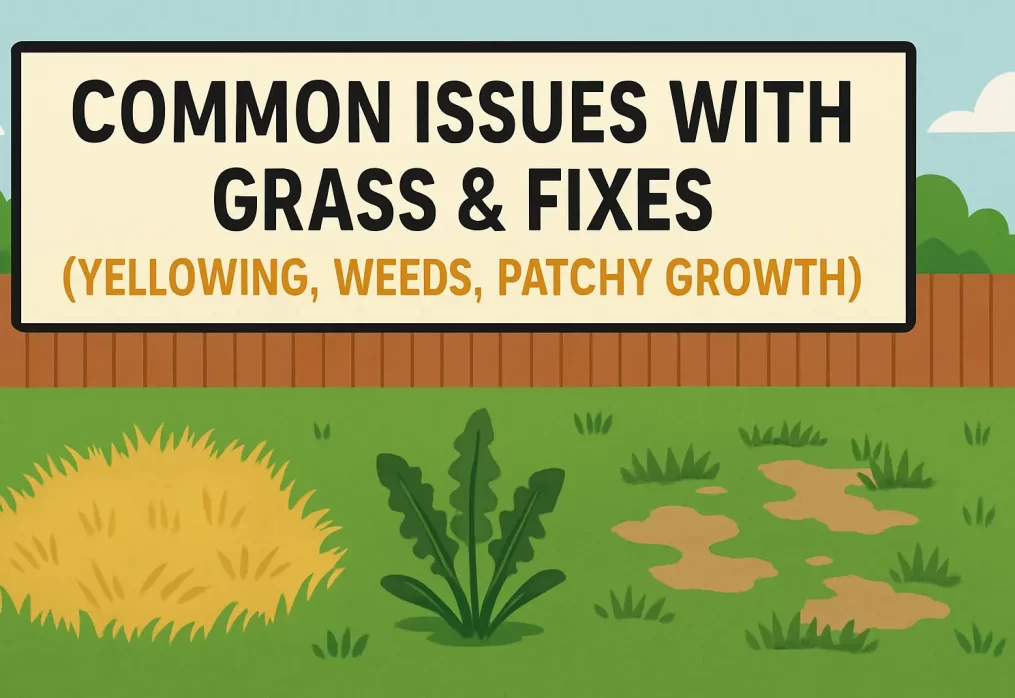Common Issues with Selection No.1 Grass (Yellowing, Weeds, Patchy Growth) & Fixes
Introduction
If you’ve ever looked out at your lawn and felt frustrated by yellow patches, weeds creeping in, or areas of uneven growth, you’re not alone. Selection No.1 Grass, despite being one of the most popular choices for lush, natural lawns in India, can sometimes face these common issues. The good news? With the right knowledge and timely care, every one of these problems can be fixed.
Understanding the Nature of Selection No.1 Grass
Selection No.1 Grass is widely chosen for residential lawns, gardens, parks, and landscapes because of its dense texture, soft feel, and appealing green color. It thrives in warm climates, tolerates regular foot traffic, and can stay green year-round if properly maintained. However, like any natural turf, it requires balanced care in terms of watering, mowing, and fertilization. ✅ Looking for durable and low-maintenance lawn solutions? Check out our Natural Selection No. 1 Lawn Grass Carpet Rolls for a lush, long-lasting garden.
Common Issues in Selection No.1 Grass
Even the healthiest lawns sometimes struggle. The three most common problems Selection No.1 Grass owners face include:
- Yellowing of leaves
- Weed infestation
- Patchy or uneven growth
Let’s break down each issue and find practical fixes.
Issue 1: Yellowing of Selection No.1 Grass
Yellowing is one of the first signs your grass is unhappy. Causes may include:
- Nutrient Deficiency – Especially lack of nitrogen or iron.
- Overwatering or Underwatering – Both extremes stress grass roots.
- Fungal Diseases – Common in damp conditions.
- Soil Compaction – Roots suffocate without oxygen.
- Heat Stress – Prolonged exposure to direct sunlight without enough water.
Fixes for Yellowing Grass
- Balanced Watering – Water deeply 2–3 times a week rather than lightly every day.
- Proper Fertilization – Use nitrogen-rich fertilizers every 6–8 weeks. Organic compost also works wonders.
- Disease Control – Apply fungicides if fungal infections are spotted.
- Soil Aeration – Relieves compaction and helps roots breathe.
- Shade Management – Trim nearby trees to ensure your lawn gets enough light.
Issue 2: Weed Infestation in Selection No.1 Grass
Weeds sneak into lawns for many reasons, including poor mowing practices, compacted soil, or excessive watering. Some common invaders include dandelions, crabgrass, and clover. These weeds not only compete for nutrients but also make lawns look unkempt.
Fixes for Weed Problems
- Manual Removal – Uproot weeds from the root to prevent regrowth.
- Mulching – Prevents weed seeds from sprouting.
- Natural Solutions – Vinegar spray or boiling water works for small patches.
- Herbicides – Use selective herbicides designed for lawns. Apply carefully to avoid damaging grass.
Issue 3: Patchy Growth in Selection No.1 Grass
Patchy lawns are frustrating. Causes include:
- Uneven Watering – Some areas dry out faster than others.
- Foot Traffic – Heavy use creates bald spots.
- Soil Problems – Poor drainage or compacted soil hinders growth.
- Incorrect Mowing – Cutting too short weakens grass roots.
Fixes for Patchy Growth
- Overseeding – Spread fresh grass seeds in bare spots.
- Aeration – Loosen soil to promote healthy root growth.
- Topdressing – Apply a thin layer of compost to boost soil quality.
- Leveling – Fill in dips with soil to ensure even growth.
Seasonal Care for Selection No.1 Grass
- Summer – Water deeply to fight heat stress.
- Winter – Avoid overwatering; grass grows slower in colder months.
- Monsoon – Ensure proper drainage to prevent fungal infections.
Best Fertilizers for Selection No.1 Grass
- Organic Options – Cow manure, compost, and bio-fertilizers.
- Synthetic Options – NPK fertilizers with higher nitrogen content.
- Tip – Fertilize every 6–8 weeks during the growing season.
Watering Schedule for Healthy Growth
Water early in the morning, 2–3 times a week. Early watering reduces evaporation loss and allows grass to dry during the day, preventing fungus.
Mowing Guidelines for Thick and Healthy Turf
- Keep grass height around 2.5–3 inches.
- Avoid cutting more than 1/3rd of the blade at once.
- Sharpen mower blades regularly for clean cuts.
Preventive Lawn Care Tips
- Test soil pH every 6 months.
- Aerate the lawn annually.
- Apply mulch or compost to retain soil moisture.
- Keep pests like grubs in check with eco-friendly treatments.
Conclusion
Selection No.1 Grass can be your ticket to a beautiful, green, and healthy lawn—but only if you stay proactive. Yellowing, weeds, and patchy growth are common but completely manageable problems. With the right care techniques—balanced watering, timely fertilization, weed control, and aeration—you can transform your lawn into a lush green carpet that stays vibrant year-round.
FAQs
1. Why does Selection No.1 grass turn yellow?
Usually due to nutrient deficiency, poor watering habits, or fungal infections.
2. How do I control weeds naturally?
Try mulching, vinegar sprays, or hand-pulling weeds before they spread.
3. Can patchy grass recover without reseeding?
Minor patches may fill in naturally with proper care, but overseeding ensures faster recovery.
4. What is the ideal mowing height for Selection No.1 grass?
Around 2.5–3 inches is best for healthy, dense growth.
5. How often should I fertilize my lawn?
Every 6–8 weeks during the growing season for best results
Last Updated on 3 months ago by Anjali Mehra Ph.D. in Horticulture (Punjab Agricultural University)
- Grass Types that Survive Frost & Snow (Uttarakhand-Specific) - December 6, 2025
- Low-Water Grass Varieties for Hilly Homes in Uttarakhand - December 1, 2025
- Mexican Grass vs Bermuda Grass – Which is Best for Indian Lawns? - November 28, 2025
